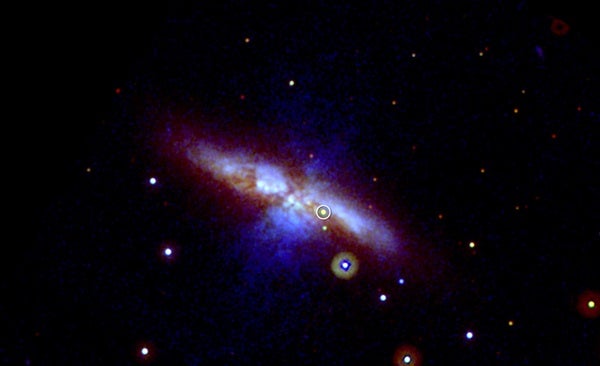To make the most of the event, astronomers have planned observations with the NASA/ESA Hubble Space Telescope and NASA’s Chandra X-ray Observatory, Nuclear Spectroscopic Telescope Array (NuSTAR), Fermi Gamma-ray Space Telescope, and Swift mission.
As befits its moniker, Swift was the first to take a look. On January 22, just a day after the explosion was discovered, Swift’s Ultraviolet/Optical Telescope (UVOT) captured the supernova and its host galaxy.
Remarkably, SN 2014J can be seen on images taken up to a week before anyone noticed its presence. It was only when Steve Fossey and his students at the University of London Observatory imaged the galaxy during a brief workshop that the supernova came to light.
“Finding and publicizing new supernova discoveries is often the weak link in obtaining rapid observations, but once we know about it, Swift frequently can observe a new object within hours,” said Neil Gehrels from NASA’s Goddard Space Flight Center in Greenbelt, Maryland.
Although the explosion is unusually close, the supernova’s light is attenuated by thick dust clouds in its galaxy, which may slightly reduce its apparent peak brightness.
“Interstellar dust preferentially scatters blue light, which is why Swift’s UVOT sees SN 2014J brightly in visible and near-ultraviolet light but barely at all at mid-ultraviolet wavelengths,” said Peter Brown from Texas A&M University.
However, this super-close supernova provides astronomers with an important opportunity to study how interstellar dust affects its light. As a class, type Ia supernovae explode with remarkably similar intrinsic brightness, a property that makes them useful “standard candles” — some say “standard bombs” — for exploring the distant universe.
Brown notes that X-rays have never been conclusively observed from a type Ia supernova, so a detection by Swift’s X-ray Telescope, Chandra, or NuSTAR would be significant, as would a Fermi detection of high-energy gamma rays.
A type Ia supernova represents the total destruction of a white dwarf star by one of two possible scenarios. In one, the white dwarf orbits a normal star, pulls a stream of matter from it, and gains mass until it reaches a critical threshold and explodes. In the other, the blast arises when two white dwarfs in a binary system eventually spiral inward and collide.
Either way, the explosion produces a superheated shell of plasma that expands outward into space at tens of millions of miles per hour. Short-lived radioactive elements formed during the blast keep the shell hot as it expands. The interplay between the shell’s size, transparency, and radioactive heating determines when the supernova reaches peak brightness. Astronomers expect SN 2014J to continue brightening into the first week of February, by which time it may be visible through binoculars.
M82 is located in the constellation Ursa Major and is a popular target for small telescopes. It is undergoing a powerful episode of star formation that makes it many times brighter than our Milky Way Galaxy and accounts for its unusual and photogenic appearance.










